#xuannü
Explore tagged Tumblr posts
Text

Jiutian Xuannü, Goddess of War, Sex and Longevity.
#Jiutian Xuannü#a.i.#chinese mythology#artificial intelligence#Xuannü#a.i. generated#玄女#a.i. art#mythology#taoism#goddess#not my art
1 note
·
View note
Text
I did some thingies for @lallxrona bcz I love their ocs sm and I just really wanted to draw these girlies in my chibi style-

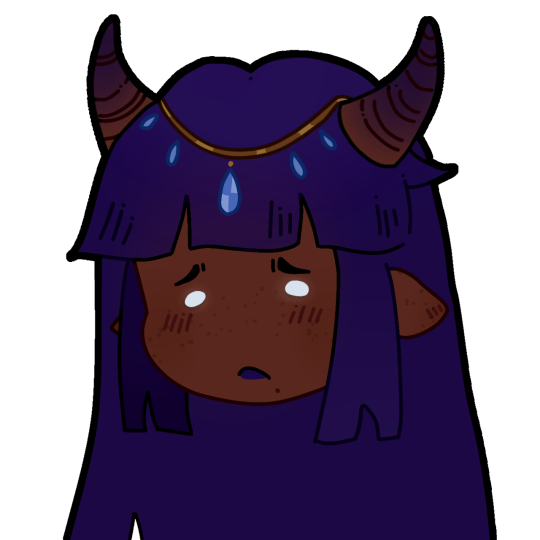
These two are transparent PNG's so they can be used as stimkers if you want :> (just make sure to credit lallxrona for the OCs and credit me for the art if you're going to use it for something puplic)


And you can use these as pfp's :D (again, just make sure to credit)
#monkie kid#lmk oc#lego monkie kid#lego monkie kid oc#monkie kid oc#not my oc#oc: dián lán#oc: indigo daughter#oc: jiutian xuannü#pfp icons#t'was a pleasure drawing these girlies :D#My art
25 notes
·
View notes
Text

Divination/moodboard for Lady Xuannü 🐰🪷
#lady xuannü#deity work#deity offerings#chinese gods#chinese mythology#chinese goddess#lady xuannu#mulan#travel#mandarin#bunny#lotus#taiwan#yay
4 notes
·
View notes
Text

Mythologically: 九天玄女 -> Jiutian Xuannü also known as the Mysterious (or Dark) Lady of the Nine Heavens is the Chinese Taoist of war, sex, and longevity (long life). It's said that she wasn't always a Taoist goddess though as there's a chance she could have predated the Taoist religion. She's known for descending from a great mist to help the Yellow Emperor fight and defeat Chi You. Jiutian Xuannü is also known to ride a phoenix and possibly be able to cause earthquakes.
My version: This lady is a badass. She's known to have fought off an entire army singlehandedly and actually manage to hold them off before dying in battle, only to be granted immortality for her sacrifice. She's also really smart as she claims to have beat everyone in the celestial realm at chess twice. She's also the one to manage to redeem YRD however this act led her to believe that demons aren't entirely evil and that they can change they just need a reason to. So this lady decided to run an experiment, she chooses a demon champion to wield her sword and fight for right down on earth. Surprisingly it works and the demon she chooses becomes a beacon of hope among the demons. Other than that she's also color-blind and has a pet phoenix.
#chinese mythology#Jiutian Xuannü#Jiutian Xuannü chinese mythology#I call her Ji-Ji#tw: war#celestial#goddess of war#2nd chances au#reincarnation au#the creed~#moodboard
15 notes
·
View notes
Text
youtube
Oriental style beauties,Jiutian Xuannü,Dunhuang.
3 notes
·
View notes
Text
[Hanfu · 漢服]Chinese immortal Hanfu <西王母/Queen Mother of the West> Based On Yuan Dynasty Taoist Temple Mural<永乐宫/Yongle Palace>
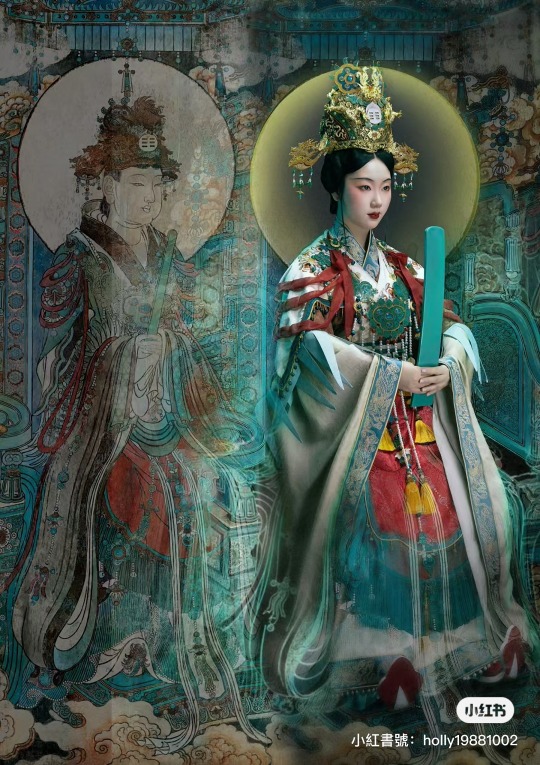
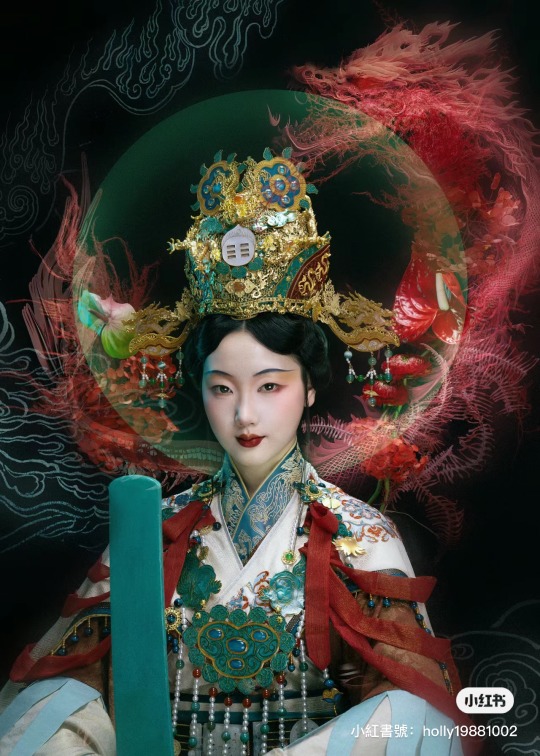
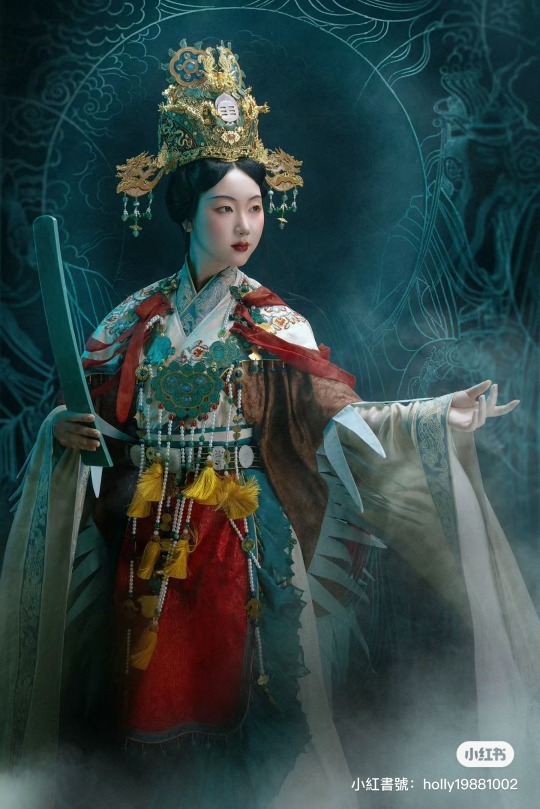
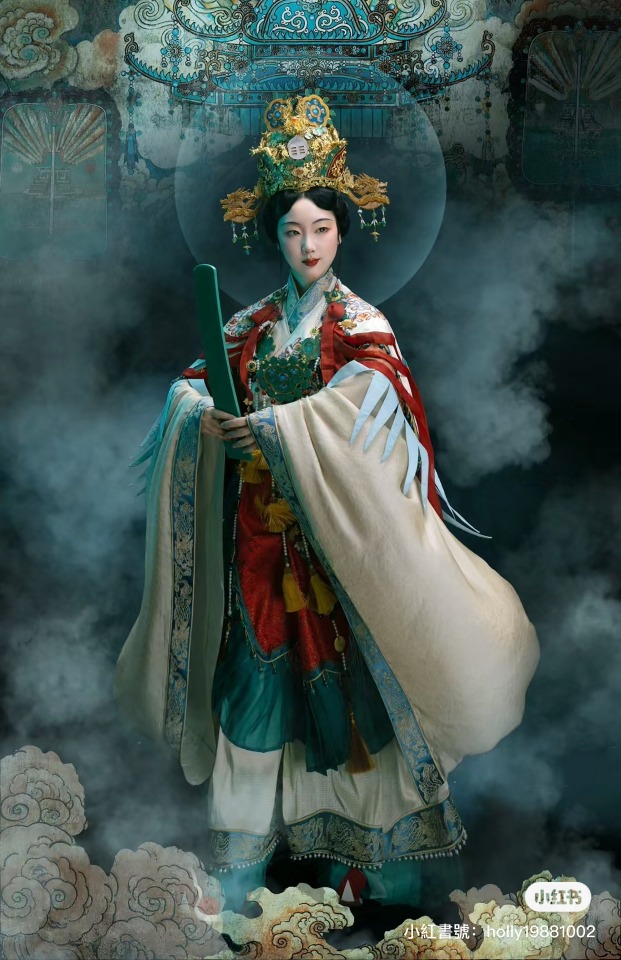
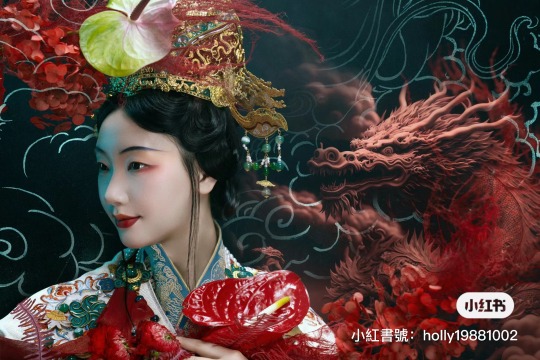
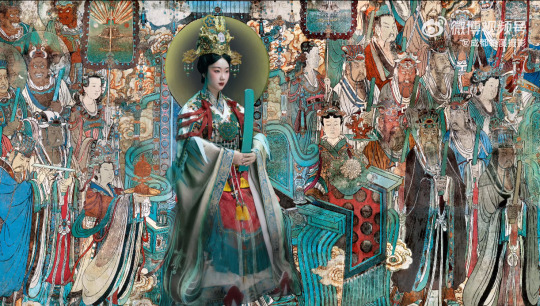
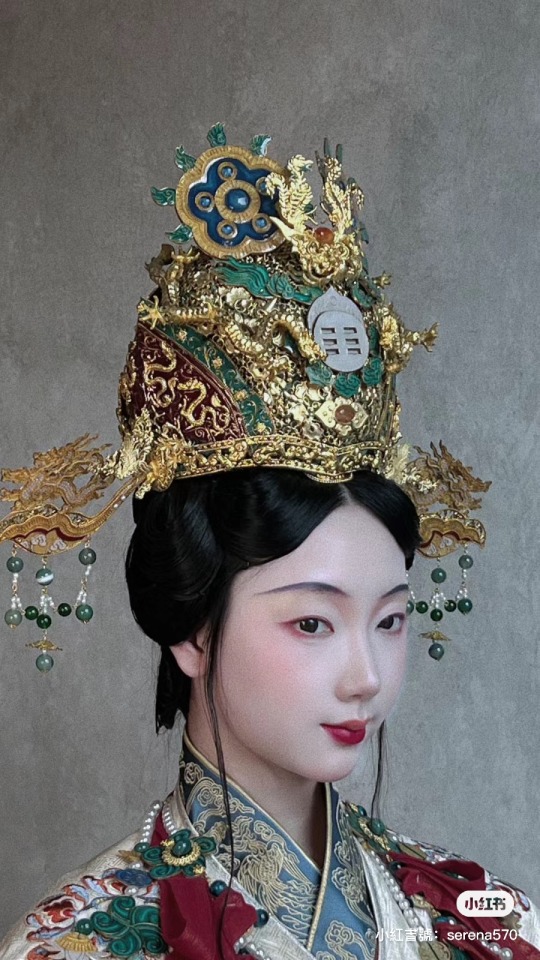
【Historical Artifacts Reference ��:
▶ China Yuan Dynasty Taoist Temple 永乐宫/Yongle Palace Mural
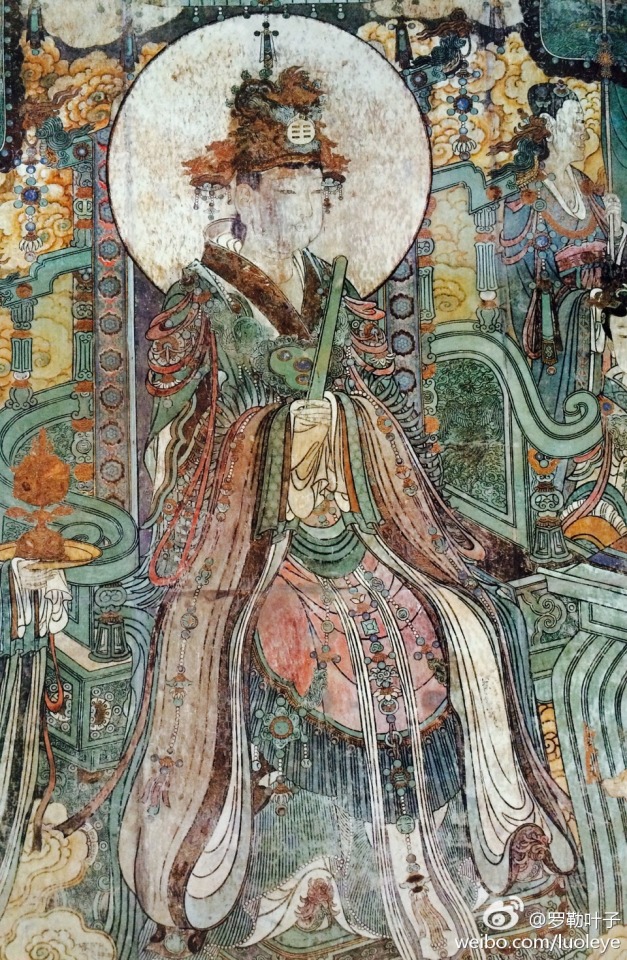
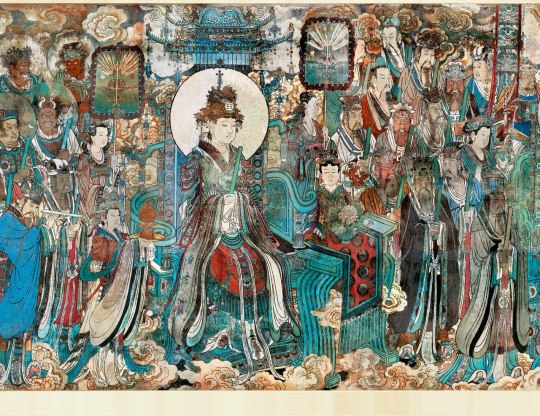
<西王母/Queen Mother of the West>
The Queen Mother of the West, known by various local names, is a mother goddess in Chinese religion and mythology, also worshipped in neighbouring Asian countries, and attested from ancient times.
The first mentions of the Queen Mother date back to the oracle bone inscriptions of the Shang dynasty (1766 – 1122 BCE). One inscription reads:
Crack-making on day IX (9th day), we divined. If we make offering to the eastern mother and the western mother, there will be approval.
Western Mother refers to an archaic divinity residing in the west. The exact nature of the Mother divinities in the Shang dynasty is unclear, but they were seen as powerful forces deserving of ritual by the people of the Shang dynasty. Originally, from the earliest known depictions of her in accounts like the Classic of Mountains and Seas during the Zhou dynasty, she was a ferocious goddess of death with the teeth of a tiger, who rules over wild beasts and sends down heavenly punishments such as pestilences. She was also mentioned as an authority ruling over other divinities such as Jiutian Xuannü, a goddess of war and sex. Other stories hold that she is a mountain goddess or a divine tigress. She is also popularly thought to have blessed the Eight Immortals with their supernatural abilities.
After her integration into the Taoist pantheon, she gradually took on associations with other aspects, such as immortality, as well.
The Queen Mother of the West is most often depicted holding court within her palace on the mythological Mount Kunlun, usually supposed to be in western China (a modern Mount Kunlun is named after this). Her palace is believed to be a perfect and complete paradise, where it was used as a meeting place for the deities and a cosmic pillar where communications between deities and humans were possible.At her palace she was surrounded by a female retinue of prominent goddesses and spiritual attendants. One of her symbols is the Big Dipper.
Although not definite there are many beliefs that her garden had a special orchard of longevity peaches which would ripen once every three thousand years,others believe though that her court on Mount Kunlun was nearby to the orchard of the Peaches of Immortality. No matter where the peaches were located, the Queen Mother of the West is widely known for serving peaches to her guests, which would then make them immortal. She normally wears a distinctive headdress with the Peaches of Immortality suspended from it.
Flourishing parasols, we reach the chronograms' extremity; Riding on the mist, I wander to Lofty Whirlwind Peak. The Lady of the Supreme Primordial descends through jade interior doors; The Queen Mother opens her Blue-gem Palace. Celestial people—What a Crowd! A lofty meeting inside the Cyan Audience Hall. Arrayed Attendants perform Cloud Songs; Realized intonations fill the Grand Empty Space. Every thousand years, her purple crabapple ripens; Every four kalpas, her numinous melon produces abundantly. This music differs from that at the feast in the wilderness— So convivial, and certainly infinite.— Wu Yun (Complete Tang Poems 1967, line 4942)
One of the earliest written references to the Queen Mother comes from the writings of the Taoist writer Zhuangzi (c. 4th century BCE):
The Queen Mother of the West obtained it [the Dao]... ...and took up her seat at Shao kuang. No one knows her beginning; no one knows her end.
Zhuangzi describes the Queen Mother as one of the highest of the deities, meaning she had gained immortality and celestial powers. Zhuangzi also states that Xiwangmu is seated upon a spiritual western mountain range, suggesting she is connected to not only the heavens, but also to the west.
Legendary encounters
In Tu Kuang-ting's text, he includes narrative accounts of the Queen Mother's encounters with legendary Chinese heroes. One such account narrates an encounter between the Queen Mother and Laozi (Lord Lao):
"In the 25th year of King Chao of the Chou dynasty (1028 BCE) …" "…Lord Lao and the realized person Yin Hsi went traveling…" "…on their behalf, the Queen Mother of the West explicated the Scripture of Constant Purity and Quiet."
In this account, the Queen Mother plays the role of Laozi's superior and is credited with the ultimate authorship of the Dao De Jing. This dichotomy of the Queen Mother as the superior is a characteristic of Shangqing Taoism, a goddess worshiping sect of Taoism of which Tu Kuang-ting was a master. There is also an account of a meeting between the Queen Mother and Laozi in Tang poetry.[18] This account however, being of traditional Taoist thought, has the Queen Mother taking an inferior role to Laozi, calling him "Primordial Lord" (the title of his highest manifestation) and pays homage to the sage.
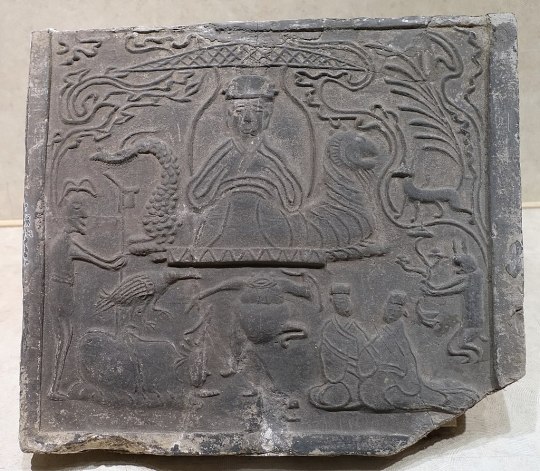
<China Han Dynasty stone-relief showing 西王母/Queen Mother of the West from Sichuan,China>
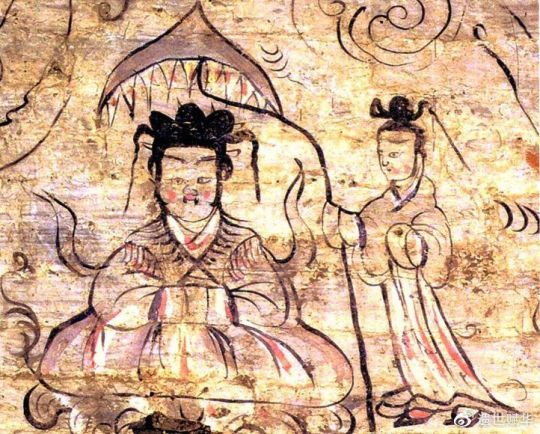
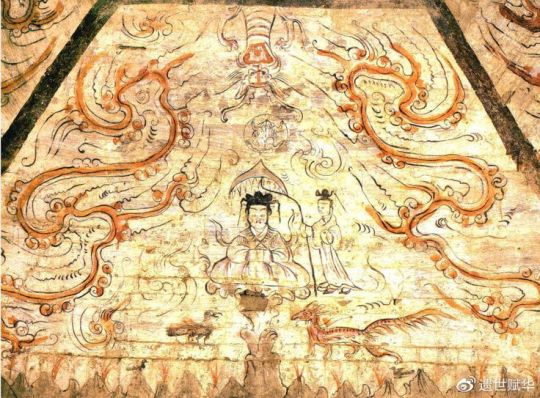
<China Wei and Jin Dynasties Mural showing 西王母/Queen Mother of the West>
————————
📸Photography post-production :@小何力
👗Hanfu & 👑Crown:@雁鸿Aimee
💄 Makeup:百丽 (临溪摄影)
👭Model:@清音音音音
🔗 Weibo:https://weibo.com/1648616372/O2R5bpBud
————————
#chinese hanfu#immortal hanfu#西王母/Queen Mother of the West#Chinese mythology#hanfu#hanfu accessories#hanfu_challenge#chinese traditional clothing#china#chinese#chinese history#china history#漢服#汉服#中華風#小何力#雁鸿Aimee#永乐宫/Yongle Palace
307 notes
·
View notes
Note
did Original! Suklha had any close friends before dying/meeting sun wukong?
Dramaa!!♡
Yes she does! Quite a few of them actually!! (Most of them are my friend's oc) She specifically picked some of the most outcasted/underestimated creatures to be her friends, they have similar opinions/views with her 🤷♀️
Suklha relies more on her instincts, kind of like figuring if this dragon is bad news or nah. If she doesn't like you in one glance, she wont try to get close.
So she has a few! Im not opposed to anyone elses ocs who wanted to be her friends too!
She's a friend of Jiutian Xuannü and Erlang too before meeting Wukong! Her closest friend is an Olmec god a friend created!
#¿ — ask#Suklha#🀄—Suklha lore#dw she's not dying alone#Wukong is NOT her knight in shining armor#😔 he's her stalker
23 notes
·
View notes
Note
I imagine in Century Egg au, MK is unfortunately going to very likely be an only child. Mainly because now, everyone is going to try to stop Wukong from pulling thay stunt again, including the Jade Emperor and Queen Mother, after MK coming into the world was such a close call. Like full-on, Lao Tzu forbidden, do not have another child it WILL kill you restrictions are placed l.
They spend so much time instilling this fact into Wukong, that they forget to pay attention to Macaque/any previously created stone eggs. XD
Macaque shows up later with the Eclipse twins' eggs (created from his time in Diyu), and the whole Celestial Realm is like; "Oh gods damn it."
Both monkeys are happy not to "bake" another stone egg anytime soon if they can... but since they've proven Wukong's point, reconciled, and reignited their romance; they can try making kids the "fun way" now ;3
Xuannü & Sunü (goddesses of you know): *both pause mid-mediatation with a realisation* Sunü: "Should we tell jiejie [Xiwangmu] about this?" Xuannü: "Nah... its their own business. I ain't no snitch." Sunü: "Yeah, thats why jiejie yelled at you for not saying anything when Sanniang ran off with that mortal..."
Fun fact; said goddesses are said to be sisters (likely sworn) of Xiwangmu/Queen Mother, as their domains (war, sexuality, longetivity, and motherhood) are said to be intertwined.
#lmk century stone egg au#stone egg talk#pregnancy tw#lmk aus#suggestive tw#shadowpeach#lmk shadowpeach au#sun wukong#liu er mihou#six eared macaque
72 notes
·
View notes
Text
I lowkey forgot to post these two reference sheet. O-O
Here are the Children of Apathy; Wheat Kernel Cookie and Sesame Mochi Cookie.
Wheat Kernel Cookie(밀알 쿠키, mil-al kuki)

Older son of Mystic Flour Cookie and Older brother of Sesame Mochi Cookie.
34 years old(Same age as Dark Choco Cookie).
Cunning, ambitious and cold but caring and loving towards his mother, his sister and Cloud Haetae Cookie.
He and his sister were titled, 'Children of Apathy; he is titled, 'Son of Apathy'.
Under the custodianship of Cloud Haetae Cookie along with his sister as teenagers after his mother and the other Beasts were sealed away years ago.
He challenges countless Cookies over the years.
Appeared in 'Dark Resolution's Glorious Return' along with his sister as a mini bosses where they challenged Dark Cacao Cookie to duel with them if the Ancient Hero wants to get passed them and face their mother then the two had lost against the king.
His design is based on Chinese Deity from Chinese Mythology, Shangdi.
He is voiced by Nolan North(Tobi/Obito Uchida from Naruto Ultimate Ninja Storm 2).
Sesame Mochi Cookie(참깨가루 모찌쿠키, chamkkaegalu mojjikuki, "Sesame Flour Mochi Cookie")

Younger daughter of Mystic Flour Cookie and younger sister of Wheat Kernel Cookie.
26 years old(Same age as Dark Brownie Cookie).
Calm, jaded and malicious but caring and loving towards her mother, her brother and Cloud Haetae Cookie.
Shee and her brother were titled, 'Children of Apathy; she is titled, 'Daughter of Apathy'.
Under the custodianship of Cloud Haetae Cookie along with her brother as teenagers after her mother and the other Beasts were sealed away years ago.
She challenges countless Cookies over the years.
Appeared in 'Dark Resolution's Glorious Return' along with her brother as a mini bosses where they challenged Dark Cacao Cookie to duel with them if the Ancient Hero wants to get passed them and face their mother then the two had lost against the king.
Her design is based on Chinese Goddess of War and Longevity, Jiutian Xuannü from Chinese Mythology.
She is voiced by Janice Kawaye(Peko Pekoyama from Danganronpa).
(BONUS: Mystic Flour Family)

#Cookie Run#Cookie Run Kingdom#Cookie Run OC#Wheat Kernel Cookie#Sesame Mochi Cookie#Mystic Flour Cookie#Reference Sheet#Guess that they'd be beef with Dark Choco and Dark Brownie soon
12 notes
·
View notes
Note
Does Jiutian Xuannü have any connection/relations to Ishtar/Inanna?
I’ll be blunt: I’d really prefer to get better Inanna questions, if possible.
Questions which deal with actual published comparative scholarship and which show actual engagement with the material are fair game and as you can see going by the past few months worth of responses I don’t dismiss these (in fact, the series of questions about Iranian-Mesopotamian interactions were among the most enjoyable to answer out of recent ones, I had fun with the question about Durga’s early history too). However, in the case of this ask there’s not even any real argument to be made here, those are two completely unrelated figures which arose in completely different cultural contexts and have no spatial overlap. I’ll try to answer it nonetheless, more under the cut.
For the sake of a hypothetical, let’s ignore the temporal and spatial differences for a moment though these would be more than enough.
Jiutian Xuannü’s association with sexuality exists in a highly specific Daoist context where sex functions essentially like neidan, the “inner alchemy” from immortality manuals and other similar literature (see Suzanne E. Cahill, Sublimation in Medieval China: The Case of the Mysterious Woman of the Nine Heavens, p. 101). Correct conduct in this sphere is a pathway to longevity. Needless to say, that offers no real parallel to any Mesopotamian material from any period; for a brief overview of Mesopotamian attitudes to sex across time and space see here, it’s also worth looking into Gioele Zisa’s The Loss of Male Sexual Desire in Ancient Mesopotamia.
Warfare is too universal of a sphere of activity for a deity to really warrant any comment here but, similarly, the cultural context is very different; for Jiutian Xuannü see Peng Liu’s “Conceal my Body so that I can Protect the State”: The Making of the Mysterious Woman in Daoism and Water Margin, for Inanna Ilona Zsolnay’s Goddess of War, Pacifier of Kings.
Iconography-wise I don’t exactly see grounds for any comparisons either. The earliest version of Jiutian Xuannü, known from Han dynasty funerary art and sometimes mentioned in later literary texts, was a bird with a woman’s head (Cahill, p. 102) which… also doesn’t exactly offer any real parallel to Mesopotamia (indeed, it’s basically a rule that deities of note lack animal parts, serpentine peripheral oddities like Tishpak and Ishtaran aside). No human-headed birds are really mentioned in Frans Wiggermann’s overview of hybrid creatures in Mesopotamian art. However, this fits in perfectly well with the host of other partially human, partially animal deities and other supernatural beings from Han dynasty sources like the Classic of Mountains and Seas. In other words, as far as I am concerned there is no real reason to suspect that Jiutian Xuannü is anything but a typical Han dynasty deity who then underwent typical shifts such a figure would as Daoism continued to develop. Incredibly hard to imagine that a deity from the other side of the continent whose cult would be already on the way out when the first references to Jiutian Xuannü start to pop up and who is not really attested in any period east of Susa would have anything to do with her. The closest thing to reception of a Mesopotamian figure in China would be the occasional references to the Sogdian version of Nanaya (I compiled relevant evidence in her wiki article), but there’s no real evidence anyone but the Central Asian immigrants would be particularly familiar with her. There is only one depiction of her from China and it’s an oddity commissioned by a Sogdian for personal use, the funerary couch from the collection of the Miho Museum:

The iconography tbh doesn’t even resemble her depictions from Sogdia save for the two orbs. Given that this is a figure worshiped right next door think how less likely it would be for a Mesopotamian figure to reach China and leave some meaningful impact at a time when there were less contacts with foreigners, let alone foreigners which would have any contact with Mesopotamia.
4 notes
·
View notes
Text
Mythic Creatures by Region & Culture
Part 8: Asia and South Pacific
The Mesopotamian entries are often culture-specific and I'll need to sort them into their respective regions in future.
allegedly Asian
Barometz; Salamander
Smaller Entries:
Akathaso, Burma, tree spirit; Barmanou, Pakistan; Benzaiten; Churel; Creatures of Azerbaijan; Dab Hmong; Dakhanavar Armenian; Ḍākinī; Death; Landlord Deities; Mountain God; Peacock Princess; Sin-you; Sky Fox; Teng; Tenghuang; Xeglun Tungusic Ainu
Akkorokamui; Amemasu; Hoyau; Kenas-unarpe; Korpokkur; Mintuci Cambodia; Koan Kroach nightmare fuel; Kting voar also Vietnam; Mrenh kongveal
China
Ao; Ao Guang; Azure Lung; Bai Lung Ma; Bai Suzhen; Bai Ze; Bao Si; Bashe; Bi Fang bird; Bixi; Black Tortoise; Boto_and_Dolphin_Spirits; Cangjie; Chang; Chi; Chinas; Chinese guardian lions; Chinese Monkey Creatures; Chinese serpent killed by Li Ji; Chinese Souls; Chiwen; Chiyou; City God; Daji; Dēnglung; Dilung; Diting; Dogs in Chinese mythology; Dong Yong and the Seventh Fairy; Dǒumǔ; Dragon turtle; Fangfeng; Fangxiangshi; Feilian; Feilung; Feng; Fènghuáng; Fengli; Flying Horse of Gansu; Four Perils; Fox Spirit; Fuxi; Fuzanglung; Fuzhu; Gangcheori; Ghosts in Chinese culture; Gonggong; Guang yi ji; Hairen; He-He Er Xian; Hong; Hòutǔ; Hun and po; Hundun; Huodou; Húxiān; Jiangshi; Jiaolung; Jin Chan; Jinmenju also Japanese; Jiutian Xuannü; Jiutou Zhiji Jing; Jiuweihu; Jué yuán (Japanese version Jueyuan); King Father of the East; Kitchen God; Kuafu; Kui; Lake Tianchi Monster; Luan; Luduan; Lung; Lungma; Lungmu; Magpie Bridge; Magu; Menshen; Mo; Mogwai; Momu; Moon Rabbit; Nian; Nine-headed bird; Nüba; Nüwa; Pangu; Panhu; Panlung; Peng; Penghou; Pig Dragon; Pipa Jing; Pixiu; Pulao; Qianlima also Korean; Qilin; Qingji; Qingniao; Qiulung; Queen Mother of the West; Sanshi; Sha Wujing; Shangyang; Shen; Shen_clam_monster; Shenlung; Shi Dog; Shuimu; Spirit Turtle; Stone Sentinel Maze; Swan Maiden Yao; Taotie; The Governor of Nanke; The Painted Skin; The Nine Peahens and the Golden Apples; Three-legged crow also Japanese and Korean; Tianguo; Tianlung; Tianma; Tu'er Shen; Tubo; Tudigong; Unicorn; Watersheep (see Vegetable Lamb of Tartary); Vermillion Bird; Wangliang; White Tiger; World Turtle; Wutong Shen; Wuzhiqi; Xian; Xiangliu; Xiao; Xiezhi; Xingtian; Xirang; Yao Grass; Yāoguài; Yellow Lung; Yeren; Yeti also Tibetan and Nepali; Yinglung; Zhenniao; Zhu Bajie; Zhulung
Hittite
Annunaki; Illuyanka the equivalent of Hurrian Ḫedammu; Hittite Goddesses of Fate
Hurrian
Annunaki; Ḫedammu the equivalent of Hittite Illuyanka; Tilla; Ullikummi; Upelluri
Iran (Persia)
Akvan Div; Al but also in Mongolia, Russia, Afghanistan, Caucasus; Almas also Turkic and Mongolia; Anguiped also Greek and Roman.; Arzhang Div; Azhdaha; Chamrosh; Div; Div-e Sepid; Fulad-zereh; Gochihr; Griffon; Huma bird; Karkadann allegedly lived in India and Persia; Manticore allegedly lived in India; Peri also Turkic, Islamic (and Indian?); Rakhsh; Shabrang; Shahbaz; Shahmaran Indo-Iranian and Turkic; Shahrokh; Sheshe; Simurgh; Sphinx in a wide sense; Takam; Tyger allegedly lived in Persia; Unicorn; Vegetable Lamb of Tartary the Chinese watersheep allegedly lived in Persia; Werehyena; Winged Unicorn; Zahhāk
Java
Antaboga, pre-Islamic, Hindu; Kakawin; Keong Emas; Wewe Gombel Korea; Bulgae; Chilseok; Dokkaebi; Dokkaebi bangmangi; Egg Ghost; Gasin (house god); Gunungsin; Gwisin; Haesindang Park; Inmyeonjo; Jihaguk daejeok toechi seolhwa; Korean dragon; Korean Virgin Ghost; Munshin; Namu doryeong; Pulgasari; Qianlima also Chinese; Ryong; Samsin Halmeoni; Seonangshin; Sosamsin; The Heavenly Maiden and the Woodcutter; Three-legged crow also Japanese and Chinese; Ungnyeo; Ureongi gaksi;
Mongolia
Al but also in Persia, Russia, Afghanistan, Caucasus; Almas also Iran and Turkic; Aq Bars, winged snow leopard, heraldry from 800s onwards, also Slavic; Mongolian Death Worm Myanmar; Manussiha; Nat; Nawarupa; Pyinsarupa; Sphinx in a wide sense; Thayé; Yokkaso
Nepal
Gurumāpā; Khyāh; Kichkandi; Lākhey; Murkatta; Yeti also Chinese and Tibetan
Philippines
Alan of the Tinguian people; Amalanhig of the Visayan; type of Aswang; Amomongo of the Visayan; Angalo of the Ilocano; Anggitay Philippine centauride, female Tikbalang; Anito; Aswang; Bakunawa; Bal-Bal; Batibat of the Ilocano; Berbalang of Mindanao towns; Berberoka northern Luzon; Bernardo Carpio; Bungisngis Meluz, Orion, Bataan and Batangas; Busaw; Buso Bagobo; Dalaketnon Cebuano; Ekek; Engkanto; Ibong Adarna; Kapre; Kataw; Kumakatok; Manananggal; Manaul; Mandurugo; Minokawa; Nuno sa punso; Philippine Mytic Creatures; Pugot; Sarangay; Sarimanok; Sigbin; Sirena; Siyokoy; Tigmamanukan; Tikbalang; Tiyanak; Wakwak
allegedly Scythian (rider culture, no written records, all inhabitants and creatures based on Greek reports)
Amazons, Amazons (List); Arimaspi north Scythia; Scythian genealogical myth; Scythian religion; Scythians; Tarand; Vegetable Lamb of Tartary
Taiwan
Hanitu; Mo-sin-a; Ta'ai; Tek-ko-kui
Thai
Apsonsi; Cha kla; Hatsadiling; Hemaraj; Kong Koi; Krahang; Krasue; Kuman Thong; Mae Nak Phra Khanong; Mae yanang; Nang Mai; Nang Ta-khian; Nang Tani; Nariphon; Ninlaret; Phi phong; Phi Tai Hong; Phisuea Samut; Pop (ghost); Sphinx in a wide sense; Sudsakorn; Suvannamaccha
Tibet
Gyalpo spirits; Ro-langs; Simhamukha; Snow Lion; Tibetan myth; Wind Horse; Yeti also Chinese and Nepali
Vietnam
H��� ly tinh; Kting voar also Cambodia; Lạc bird; Nghê; Rồng ; Vietnamese Dragons
Turkic
Äbädä, also found in Siberian mythology; Abasy, also found in Siberian mythology; Aiy Yakut; Al in Mongolia, Russia, Afghanistan, Caucasus; Al Ana; Al Basty from Sumerian; Alara, also found in Siberian mythology; Almas also Iran and Mongolia; Archura; Asena; Ayaz Ata; Bai Baianai also Yakut; Basty Turkic alp or mare; Bichura Turkic household spirit; Chai nenesi; Chesma iyesi; Çor also Siberian; Ergene iyesi; Erkenek; Hortdan; Irshi; Itbarak; İye; Konrul; Korbolko; Kormos; Mhachkay includes Tatar lore; Mu shuvuu; Örek; Peri also Persian, Islamic (and Indian?); Qarakorshaq; Sazakan; Shahmaran Indo-Iranian and Turkic; Sheka; Shurali; Su iyesi; Susulu; Tepegöz; Tulpar; Turul also Hungarian; Upiór also Slavic; Uylak; Werewolf; Yekyua; Yelbeghen; Yer iyesi; Yer-sub; Yuxa
Turkish
Gelin; İn Cin; Uzuh
Siberia
Äbädä, also found in Turkic mythology; Abasy, also found in Turkic mythology; Aiy Yakut; Alara, also found in Turkic mythology; Bai Baianai, also found in Turkic mythology; Çor also Turkic; İye also Turkic\; Menk; Oksoko Yakut; Ongon; Pitsen; Sihirtia; The Great Snake; Yekyua; Yelbeghen
South Pacific Islands
Abaia: Fiji, Solomon and Vanuatu Islands. ; Abere, unspecified "Melanesia"; Adaro, Solomon Islands, merfolk; Aitu, from Maori to various east and west Polynesian cultures; Amai-te-rangi Cook Islands; Apukohai, Hawaii; Aremata-Popoa and Aremata-Rorua; Atonga Samoa; Atua; Auriaria Kiribati; Avatea Cook Islands; Baloma; Barong; Flaming Teeth Fiji; Gazeka Papua New Guinea; Hatuibwari Solomon Islands; Ila (Samoan myth); Kae and Longopoa; Kai-n-Tiku-Aba; Kalamainu'u Hawaii; Kawas; Kihawahine; Kupua Hawaii; Losi Samoa; Menehune Hawaii; Miru Cook Islands; Moʻo Hawaii; Moso's Footprint Samoa; Nawao Hawaii; Nei Tituaabine; Nganaoa; Nightmarchers Hawaii; Pahuanui Tahiti and Society Islands; Pua Tu Tahi; Rogo-Tumu-Here; Savali; Sina and the Eel; Talamaur Vanuatu; Tamangori; Tangaroa; Taotao Mo'na Mariana Islands; Tapairu Cook Islands; Tiʻitiʻi; Tikokura; Tinirau similar to Māori Tinirau and Kae;
Māori
Aitu also common in all parts of East and West Polynesia, sometimes with slightly different meanings; Atua; Hāhau-whenua; Hākuturi; Hawakai; Hemā; Hine-nui-te-pō; Kiwa; Kumi Lizard; Kurangaituku; Maero; Manaia; Maori ghosts; Matuku-tangotango; Moehau; Nuku-mai-tore; Pania of the Reef; Paoro; Patupaiarehe; Ponaturi; Pouākai; Taniwha; Taoroinai; Te Wheke-a-Muturangi; Tinirau and Kae; Tipua; Waitoreke; Whakatau; Whiro
Indian Ocean Islands
Folklore of the Maldives; Rannamaari
Japan (separate categories for Ainu and Okinawa)
Abumi-guchi; Abura-akago; Abura-sumashi; Aka Manto; Akabeko; Akaname; Akashita; Aketeko; Akubōzu; Akugyo; Akuma; Akurojin-no-hi; Ama no Fuchigoma; Amabie; Amanojaku; Amanozako; Amazake-babaa; Amefurikozō; Ameonna; Amikiri; Amorōnagu; Aoandon; Aobōzu; Aonyōbō; Aosaginohi; Arikura-no-baba; Ashi-magari; Ashinaga-tenaga; Ayakashi; Azukiarai; Azukibabaa; Azukihakari;
Bake-danuki; Bake-kujira; Bakemono; Bakeneko; Bakezōri; Baku; Banchō; Basan; Betobeto-san; Binbōgami; Biwa-bokuboku; Boroboroton; Bukit Timah Monkey Man WWII Japanese soldiers in Bukit Timah (Singapore) saw this; Byōbunozoki;
Chimimōryō; Chōchin'obake; Chōchinbi;
Daidarabotchi; Daikokuten; Danzaburou-danuki; Datsue-ba; Dodomeki; Dōsojin;
Ehon Hyaku Monogatari; Emishi; Enenra;
Fūjin; Funayūrei; Furaribi; Furutsubaki-no-rei; Futakuchi-onna;
Gagoze; Gashadokuro; Gazu Hyakki Yagyō; Gohō dōji; Goryō;
Hagoromo (swan maiden play); Hakuzōsu; Hanako-san; Hannya; Hare of Inaba; Harionagu; Hashihime; Heikegani; Hell Courtesan; Hibagon; Hiderigami; Himiko; Hito-gitsune; Hitodama; Hitotsume-kozō; Hitotsume-nyūdō; Hone-onna; Hotoke; Hyakki Tsurezure Bukuro; Hyakki Yagyō_Wild Hunt; Hyōsube; Hyottoko;
Ibaraki-dōji; Ikiryō; Ikuchi; Inari Ōkami; Inugami; Inugami Gyōbu; Ishinagenjo; Isonade; Issie; Issun-boushi; Itsumade; Ittan-momen;
Janjanbi; Japanese Serpent; Jikininki; Jinmenju also Chinese; Jinmenken; Jorōgumo; Jubokko; Jueyuan (Chinese version Jué yuán);
Kaibyō; Kamaitachi; Kami; Kamikiri; Kappa; Karura; Kasa-obake; Kasha; Kawauso; Kechibi; Keneō (oni); Kidōmaru; Kijo (folklore); Kinoko; Kitsune; Kitsune no yomeiri; Kitsunebi; Kiyohime; Kodama; Kōga Saburō; Komono; Konaki-jiji; Konjaku Gazu Zoku Hyakki; Konjaku Hyakki Shūi; Konpira Gongen; Koromodako; Koto-furunushi; Kotobuki; Kōya Hijiri; Kubikajiri; Kuchisake-onna; Kudagitsune; Kudan; Kumiho; Kuraokami (ryu); Kuro-shima (Ehime); Kurozuka; Kuzenbo; Kuzunoha; Kuzuryū;
Makuragaeshi; Maneki-neko; Matarajin; Mazoku; Megijima; Menreiki; Miage-nyūdō; Mikaribaba; Mikoshi-nyūdō; Misaki; Mishaguji; Mishihase; Mizuchi; Mokumokuren; Momiji; Momotarō; Mononoke; Mōryō; Mujina; Myōbu;
Namahage; Namazu; Nekomata; Ningen; Ningyo; Niō; Noderabō; Noppera-bō; Nue; Nuppeppō; Nurarihyon; Nure-onna; Nuribotoke; Nurikabe; Nyūdō-bōzu;
Oboroguruma; Ochimusha; Ōkubi; Okuri-inu; Ōmukade; Oni; Oni Gozen; Onibi; Onihitokuchi; Onikuma; Onmyōji; Onryō; Ōnyūdō; Ootakemaru; Orochi; Osakabehime; Osaki; Otoroshi; Oukami; Ouni;
Raijin; Raijū; Rashōmon no oni; Reikon; Rōjinbi; Rokkaku-dō; Rokurokubi; Ryū; Ryūgū-jō; Ryūjin;
Sakabashira; Samebito; Sankai; Sarutahiko Ōkami; Satori; Sazae-oni; See-Hear-Speak No Evil; Sessho-seki; Setsubun; Shachihoko; Shapeshifter; Shibaemon-tanuki; Shichinin misaki; Shidaidaka; Shikigami; Shikome; Shinigami; Shiranui; Shirime; Shiryō; Shōjō; Shōkera; Shuihu; Shuten-dōji; Smallpox demon; Sōjōbō; Sorei; Sunekosuri; Suzuka Gozen;
Takaonna; Takarabune; Tamamo-no-Mae; Teke Teke; Tengu; Tenka; Tennin; Tenome; Tentōki and Ryūtōki; Tesso; Three-legged crow also Chinese and Korean; Tōfu-kozō; Toyotama-hime; Tsuchigumo; Tsuchinoko; Tsukumogami; Tsukuyomi-no-Mikoto; Tsurara-onna; Tsuru no Ongaeshi; Tsurube-otoshi; Tsurubebi;
Ubagabi; Ubume; Umi zatō; Umibōzu; Ungaikyō; Ushi no toki mairi; Ushi-oni; Uwan;
Waira; Wani; Wanyūdō; Watatsumi;
Yako; Yakusanoikazuchi; Yama-uba; Yamabiko; Yamabito; Yamainu; Yamajijii; Yamata no Orochi; Yamawaro; Yanari; Yashima no Hage-tanuki; Yato-no-kami; Yobuko; Yōkai; Yōsei; Yosuzume; Yotsuya Kaidan; Youkai; Yuki-Onna; Yume no seirei; Yūrei;
Zashiki-warashi; Zennyo Ryūō; Zuijin; Zashiki-warashi
Okinawa
Kijimuna
allegedly Arabic Cinnamologus
Morocco Aisha Qandicha
Mesopotamia Abyzou; Annunaki; Anzû; Ardat-lilî; Beings of Irkalla or Kur; Bull of Heaven; Dagon; Edimmu; Ghosts in Mesopotamian culture; Hanbi; Humbaba; Igigi; Kilili; Kulullû; Kusarikku; Labbu; Lahamu; Lamashtu; Lilin also in Jewish folklore; Lotan; Lugal-irra; Lulal; Mukīl rēš lemutti; Mušḫuššu; Mušmaḫḫū; Namtar; Ninimma; Ninurta; Pazuzu; Rabisu; Scorpion men; Sea goat; Serpopard; Seven-headed serpent; Six-headed Wild Ram; The Four Winds; Tiamat; Udug; Ugallu; Umū dabrūtu; Uridimmu; Urmahlullu; Wild Man, Wild Woman ; Wild Men, Wild Women Enkidu; Zaqar
allegedly Mesopotamian Sirin
Akkadian Abkallu, also Sumerian; Akhkhazu, later Babylonian; Alû also Sumerian, an utukku with no mouth, ears, lips; Asag also Sumerian; Bašmu (possibly other parts of Mesopotamia, but badly attested); Lilu; Ušumgallu
Assyrian Adrammelech killed an Assyrian king; Alal references Babylonians
allegedly Assyrian Aralez in Armenian folklore, Semiramis controls an Aralez
Babylonian Akhkhazu, earlier Akkadian; Alal from Chaldean-Assyrian sources; Kulilu
Sumerian Abkallu, also Akkadian; Al Basty, later also in Turkic traditions; Alû also Akkadian, an utukku with no mouth, ears, lips; Asag also
Akkadian Kuli-ana; Palm Tree King#
Mesopotamian (Other) Atargatis Canaanite goddess; Tannin Canaanite; Yam Canaanite
Buddhism
Acala, Vajrayana Buddhism & East Asian Buddhism; Apalala a naga king; Apsara; Asura; Āṭavaka; Cakrasaṃvara Tantra; Ḍākinī; Diting; Girimekhala; Hayagriva; Heruka; Hevajra; Hungry Ghost; Kalaviṅka; Kangiten Buddhism in Japan; Kṣitigarbha; Kuṇḍali; Mahakala; Mahamayuri; Mahoraga; Manjushrikirti; Mara; Mucalinda; Nariphon; Niō; Preta; Rakta Yamari; The sixteen dreams of King Pasenadi; Trailokyavijaya; Tulpa; Vajrakilaya; Vajrayakṣa; Vemacitrin; Wisdom King; Wrathful deities
Jainism Ambika; Dharanendra; Gomukha; Jwalamalini; Mahoraga; Nabhi; Rishabhanatha
India
Aghasura asura in shape of 8 mile serpent (500 CE to 1000 CE, but most likely between 800 and 1000 CE); Agni_deity; Airavata; Akshayavata tree (estimated between the 4th and 15th century CE. Some parts of the text may be from the 750 to 1000 CE period.); Anasuya; Andhaka asura with 1000 heads 2000 eyes 1000 arms; Angiris; Apsara; Arjuna; Asi; Asura; Bakasura a rakshasa (despite "asura" in the name); Barbarika; Basnak Dau; Bhagadatta; Bhargava; Bhoota; Bhramari; Bhringi; Brahmahatya; Brahmarākṣasaḥ; Buru; Chakora; Chana and Munda; Chaturbhuja; Chedipe; Chidambara Rahasiyam; Chinas; Chir Batti ghost light; Chitrāngada; Chyavana; Creatures from Vetala Tales; Daayan; Daitya; Daksha\; Daksha yajna; Danava; Daruka; Dawon; Devas; Devatas; Durgamasura; Durukti; Dvarapala; Dvipa; Gādhi; Gaja; Gajasimha; Gaṇa; Gandaberunda; Gandharva; Garuda; Ghosayatra Parva; Grahana; Guhyaka; Gusainji Maharaj; Halahala; Hamsa; Haryashvas and Shabalashvas; Hidimba; Hiranyakashipu; Hiranyaksha; Ichchadhari naag; Ila; Ilavida; Ilvala and Vatapi (asura); Iravati; Jahnu; Jarita; Jvarasura; Kabhanda; Kālakeya ; Kālakeyas; Kalanemi (asura); Kalanemi (Ramayana); Kaliya; Kamadhenu; Kamakhya; Ketu; Keukegen; Kimpurushas; Kinnara; Kirmira; Kirtimukha; Koka and Vikoka; Kotavi; Kubera; Kumbhakarna; Kumbhāṇḍa; Kuntilanak ; Kurma; Kuttichathan; Lajjā Gaurī; Mada; Madhu-Kaitabha; Madhusudana; Mahabali; Maharajikas; Mahishasura; Mahoraga; Makara; Manasa_Snake_Goddess; Mānasaputra; Mande Barung; Maṇibhadra; Manohara; Mara_Goddess2 identical name to another death goddess Mara_Goddess (unrelated???); Maricha; Matsya; Mayasura; Monkey-man of New Delhi; Mṛtyu; Mukasura; Naga; Naga fireballs; Naga people; Nagaraja; Naimiṣāraṇya; Nandi; Narakasura; Narantaka-Devantaka; Narasimha Half human / Half Lion --> how Vishnu fulfills a prophecy like Eowyn or MacBeth; Navagunjara; Nivatakavacha; Pahlavas; Panchajanya; Panchamukha; Pichal Peri; Pippalada; Pishachas; Pitr; Poubi Lai; Prahlada; Pratyangira; Puloman; Putana; Rāgarāja; Rākshasas; Raktabīja; Ravana; Rishyasringa; Rukmavati; Samagana; Sampati; Sarama; Sarpa Kavu; Shahmaran Indo-Iranian and Turkic; Shambara; Shankha; Shatarupa; Shesha; Shikhandi; Shukra; Sphinx in a wide sense; Srbinda; Subahu; Sunda and Upasunda; Suparṇākhyāna; Ten Giant Warriors; Tree of Jiva and Atman; Tripurasura; Trishira; Tumburu; Ucchusma; Uchchaihshravas; Ulupi; Upamanyu; Vadavagni; Vahana (Mount of a Deva); Vajranga; Vanara; Varaha; Varahi; Vasuki_Naga_King; Vel; Vetala; Vidyādhara ; Vidyādharas; Viprachitti; Viradha; Vishala; Vritra; Vritra (dragon); Vyaghrapada; World Elephant; World Turtle; Yaksha; Yakshini; Yali; Yama; Yamaduta; Yamantaka
allegedly Indian Abarimon; Acheri; Aeternae; Astomi Pliny the Elder; Bragmanni; Calingae Pliny the Elder; Crocotta; Gold-digging ant; Griffon; Indus worm; Karkadann; Kratu; Mandi; Manticore; Monopod; Nuli; Odontotyrannus; Panther; Pard; Rompo; Salabhanjika; Sciritae; Sharabha; Tandava; Unicorn; Wild Man, Wild Woman ; Wild Men, Wild Women
Ayyavazhi Sect Kroni
Assam Baak
Bengali Bengali myths; Byangoma
Kannada Nale Ba
Kashmir Bramrachokh will-o-wisp; Rantas
Kerala Aana Marutha
Malayalam South India; Kallana
Manipur / Meitei Haosi Namoinu; Helloi; Hingchabi; Kanglā Shā; Kao; Keibu Keioiba; Khoirentak tiger; Khongjomnubi Nonggarol; Lai Khutshangbi; Meitei dragons; Meitei Mythic Creatures; Nongshāba; Pākhangbā; Sagol kāngjei; Samaton; Uchek Langmeitong; Umang Lai Sanamahism; Yenakha Paotapi Sri Lanka; Devil Bird; Maha Sona; Nittaewo; Reeri Yakseya; Sphinx in a wide sense; Tharaka; Yakseya and Yakka
Tamil Mamuni Mayan; Nadi astrology; Tamil myth
Indonesia Babi ngepet; Bukit Timah Monkey Man Singapore; Hainuwele; Hantu; Hantu Air; Hantu Bongkok; Hantu Raya; Hantu Tinggi; Jenglot; Kuntilanak also India; Lang Suir aka Langsuyar; Malay Creatures; Manseren Manggoendi; Nyi Roro Kidul; O Tokata; Orang bunian; Orang Mawas; Orang Minyak; Orang Pendek; Pelesit; Penanggalan similar to Philippines Manananggal; Pocong; Polong; Putri Tangguk; Rangalau Kiulu Phantom; Seri Gumum Dragon; Seri Pahang; Singa; Suanggi; Suangi; Sundel bolong; Tuyul; Warak ngendog
allegedly Malay Á Bao A Qu; Abath
Bali Bhoma; Gajamina; Leyak; Ogoh-ogoh
Flores Ebu gogo
Notify me about any mistakes or if any of these mythic figures, beings and creatures should not be used in art or fiction.
#mythic creatures#mythic creature list#legendary creatures#legendary creature#legendary being#legendary beings#creature list#legendary creature list#monster list#list of monsters
6 notes
·
View notes
Text

Offering for Lady Xuannü 🥰🌷
#lady xuannü#deity offerings#deity work#moodboard#deity#goddess#chinese mythology#chinese gods#tulips
0 notes
Text
Reincarnation au: a-z fun facts
A - Ao Lie is Mei's peepaw and legal guardian
B - Bi Wukong
C - Casanova is a nickname Macaque gave Ma even though it's totally in an ironic sense
D - DBK is also called the Purple Ox
E - Erlang Shen shows up (a few times)
F - Five arcs are planned
G - Muzha hits someone with guitar
H - Huntsman whistles a creepy version of Spin Spider Spin
I - "In deeds and in words" is the current name of the story
J - Ji-Ji is what I call Jiutian Xuannü cause it's a lot shorter
K - The Skeleton Key is used again
L - Macaque is lactose intolerant
M - Mo can talk
N - Nezha probably shows up less then his brother Muzha
O - Demon Olympics special
P - PIF is known as the best thief in all of China
Q - Qi is Wukong's last name now, Qi Wukong and Qi Xiaotian.
R - Rumble, Savage and Macaque see each other as brothers because they see it as being triplets
S - Shadowpeach (eventually)
T - Tang is polyglot
U - U all should know there is some retconning
V - (uh freebie) Sandy, DBK, and Ruyi used to all be very close, they are brothers who grew a part
W - Wukong and Bai He have dyslexia
X - (Another Freebie) Red Son and Macaque go by Red/Hong Hai'er and Mac until they learn their past selves names
Y - Yigong city is the name of the demon city Wukong has to protect
Z - (Last Freebie) Wukong gets a sword :3 as he doesn't want to use the staff because he thinks it rightfully belongs to MK
24 notes
·
View notes
Text
Xuan-Yuan Sword: Mists Beyond the Mountains launches July 26 for PC, later in 2023 for Switch
Gematsu Source(from July 12th)
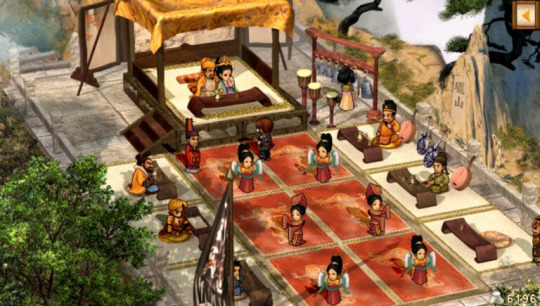
Xuan-Yuan Sword: Mists Beyond the Mountains will launch for PC via Steam on July 26, followed by Switch later in 2023, publishers Eastasiasoft and Gamera Games, and developer Softstar Entertainment announced.
Here is an overview of the game, via its Steam page:
The Journey of a Frankish Knight in the Tang Empire
Xuan-Yuan Sword: Mists Beyond the Mountains is a classic turn-based RPG. Under the orders of Pepin III, the Frankish Knight Septem has embarked on a long journey to seek the Invincible Arts of War. Starting from the canals of beautiful Venice, the great knight’s path has spanned the Middle East, Western Regions on his way to the mystical orient. In his adventures, Septem has drawn into the intricate power disputes between local powers, along with the decade-spanning ambitions of the dark lord, Satan.
China enjoys peace and prosperity under the rule of the Tang Empire, Europe finds itself embroiled in the Dark Ages, the Arabian Empire is ascendant, and all the while, the march of progress brings these disparate cultures together. From ancient times, Chinese legends have spoken of the Xuan-Yuan Sword and Spirit Fusion Pot, along with the rise of great legends in the new era…
A Symphony of Western and Eastern Culture
The scope of Xuan-Yuan Sword: Mists Beyond the Mountains covers a wide range, spanning all of Eurasia and covering the Arab World, Francia, and China. From the canals of Venice, Damascus to the beautiful Chang’an, the story introduces unique architectural styles, clothing, food, and customs.
A Fusion of History and Fantasy
The story of Xuan-Yuan Sword III takes place in an era of collision between East and West, covering a range of historical events that include the Battle of Talas, the Arabian Civil War, and An Lushan Rebellion interspersed through character dramas. Xuan-Yuan Sword III perfectly integrates history with Chinese and Western mythology. Players will encounter unique historical enemies such as Merovingian soldiers, the Venetian navy, the Abbasid Caliphate, Tang soldiers, and Taoists along with unique mythical creatures such as centaurs, Medusa, the Black and White Reapers, and the Xuannü of the Nine Heavens.
Unique Spirit Fusion Pot System
Players can use the Spirit Fusion Pot to capture enemies in battle. Items and monsters can be used to craft a new item or monster from the codex. Users can craft items and monsters from the Eastern or Western altars, which the resulting item differing based on the selected altar.
Unique Ink Painting Art Style
The game features a beautiful traditional Chinese style, with the game map, battle backgrounds, and characters all painted in unique oriental ink.
Improvements and Changes
16:9 high-resolution graphic.
User interface rework.
High-resolution item texture.
Controller support.
China Episode, originally added in mobile version.
#Xuan-Yuan Sword: Mists Beyond the Mountains#Xuan-Yuan Sword#Xuan-Yuan Sword III#Softstar Entertainment#Gamera Games#Eastasiasoft#RPG#Gematsu
6 notes
·
View notes
Text

Following our activity check, the following faceclaim and deity is now free to be roleplayed.
Ni Ni, actress
Jiutian Xuannü, chinese goddess
0 notes
Text

Myūtanto has been hiding from Wukong for a few months and she had close calls so she made disguises for herself. This is Xuannü.
The Yandere Wukong au belongs to @lopsushi
0 notes